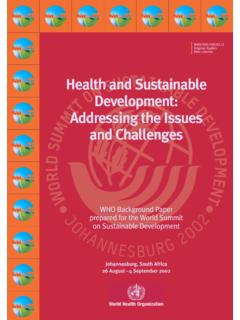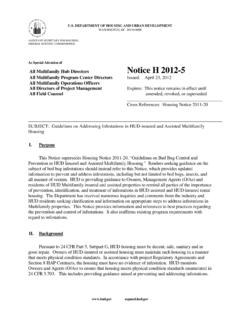Transcription of Addressing the Needs of Young Children in Child Welfare ...
1 BULLETIN FOR. PROFESSIONALS. November 2013. Addressing the Needs of Young Children in Child Welfare : What's Inside: Child Welfare and early Part C Early intervention Promising strategies Intervention Services Funding strategies Resources Enactment of the Part C referral provisions in the 2003 reauthorization of the Child Abuse Prevention and Treatment Act (CAPTA) and in the Individuals with Disabilities Education Improvement Act of 2004. (IDEA) opened the door to a powerful partnership with great potential benefits for Children under age 3 involved in substantiated cases of abuse or neglect and their families.
2 For Child Welfare administrators, these provisions offer tools to enhance policy and practice and ensure compliance with Federal Child Welfare requirements that focus on Child well-being. The provisions also connect Child Welfare staff to Child Welfare Information Gateway Children 's Bureau/ACYF/ACF/HHS. 1250 Maryland Avenue, SW. Eighth Floor Washington, DC 20024. Email: Addressing the Needs of Young Children in Child Welfare : Part C Early Intervention Services early intervention service providers, which the very Young .
3 In 2011, percent of can help Child Welfare staff in assessment, maltreatment victims were ages birth to 3, service delivery, and permanency planning. with Children younger than 1 year having This partnership can expand the array of the highest victimization rate ( per supports and resources for Children and their 1,000 Children of the same age group) ( caregivers to promote safety, permanency, and Department of Health and Human Services, well-being. 2012b). One-fifth (20 percent) of Children in foster care are under the age of 3 ( This bulletin describes the intersection of Department of Health and Human Services, Child Welfare and early intervention, provides 2012a).
4 A national study found that more an overview of Part C, highlights the benefits than two-fifths ( percent) of Children of Part C for Child Welfare , and outlines how ages 1 to 5 who were part of a maltreatment Child Welfare professionals can support Part investigation had some developmental need C efforts. It also describes implementation that may have qualified them for services challenges and provides promising strategies under Part C (Casanueva et al., 2012). for implementing Part C provisions, including examples from the field.
5 Providing early services and intervention to support the healthy development of Young Children can have positive effects that last throughout childhood and into adulthood (Center on the Developing Child at Harvard University, 2010). These services can impact Children in a variety of domains, including There is significant overlap in the population physical and mental health, language and of Young Children with substantiated abuse communication, cognitive development, and or neglect and those who experience social and emotional development (National developmental delays.)
6 Federal legislation has Early Childhood Technical Assistance Center, recognized this through provisions for early 2011). intervention and requirements for Child Welfare professionals to refer potentially eligible Early Intervention Legislation Children to early intervention programs for In recognition of these risks and the benefits identification. of early intervention, the Keeping Children and Families Safe Act of 2003 ( 108-36), Special Needs of Children in which reauthorized CAPTA, required States Child Welfare to develop provisions and procedures for Research shows that Children who are referral of a Child under age 3 who is involved abused or neglected often experience in a substantiated case of Child abuse or physical, cognitive, emotional, behavioral, neglect to early intervention services funded and social problems, including attachment under Part C of the Individuals with Disabilities disorders, cognitive delays.
7 And altered brain Education Improvement Act ( 106(b)(2). development ( Child Welfare Information Gateway, 2009). This risk is greatest for This material may be freely reproduced and distributed. However, when doing so, please credit Child 2. Welfare Information Gateway. Available online at Addressing the Needs of Young Children in Child Welfare : Part C Early Intervention Services (A)(xxi)). The 2004 reauthorization of IDEA Establish a State Interagency Coordinating contains language parallel to Council (ICC) to advise and assist the lead agency in implementing the Part C.
8 IDEA 2004 also details specific requirements program. The ICCs include representatives for State early intervention programs (EIPs), from various State agencies, including the which are administered by lead agencies in State Child Welfare agency responsible for each State (including departments of health, foster care, and at least 20 percent of the developmental disability, social services, members must be parents of Children with Children and families, or education). The lead disabilities. (For additional information agencies apply annually for their Part C grant about the ICCs, including State websites, awards and must meet certain requirements visit the Early Childhood Technical to participate.)
9 The following are examples of Assistance Center website at http://. State Part C requirements: ). Ensure that appropriate early intervention To view the full version of IDEA and the final (EI) services will be available to all eligible regulations, which were released in 2011, infants and toddlers in the State, including visit those who are in foster care, in the custody (statute) and http://idea. of a public Child Welfare agency, or otherwise considered a ward of the State. pdf (final regulations). To view nonregulatory Implement a comprehensive Child Find guidance from the Department of Education system to identify, locate, and evaluate about changes to Part C made in the final Children needing early intervention services regulations, view and to raise public awareness about what org/uploads/file_assets/attachments/12/.
10 EI services are available. The lead agency original_Final_Regulations-_Part_C-DOC-A LL. must coordinate Child Find activities with pdf. other programs, including Child protection In general, Children ages 3 to 21 with and foster care. (For more information disabilities can receive special education about Child Find, visit http://www. as outlined in Part B of IDEA. For more information about Part B, visit the asp.). Department of Education at http://idea. 1 IDEA requires States seeking grants to include in their or the National Dissemination Center applications a description of the State policies and procedures for Children with Disabilities at http://nichcy.














